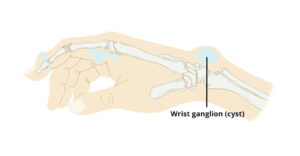Ganglion Cyst on Wrist
Last Updated on October 30, 2023 by The SportsMD Editors
Ganglion cysts on wrist are benign soft tissue growths that usually appear at the wrist, but can occur at virtually any joint. Under a microscope, a ganglion cyst consists of loosely oriented sheets of fibrous tissue with a few live cells to maintain and repair the fibrous tissue layers. They are filled with a gelatinous material that resembles synovial fluid, the fluid that lubricates joints, but is thicker and the components are in different proportions than in synovial fluid. Ganglion cysts are connected to joints by tortuous pedicles, or stalks.
Theories abound regarding how the ganglion cyst developed. Originally, they were thought to be simple herniations, or out-pouchings, of the lining of a joint, but as there is no synovial lining present within the cyst on microscopy, this is unlikely. They have also been postulated to be due to chronic inflammation, or irritation of the joint, but likewise there are none of the typical cellular inflammatory changes in a ganglion cyst, making this theory unlikely as well.
Three of the most plausible theories on how ganglion cyst develop:
1) The capsular rent theory: A tear forms in the joint capsule, the fibrous coat of a joint sealing it off from outside tissue and keeping synovial fluid in the joint. This may be due to the poor functioning of the joint leading to areas of weakness in the capsule. Some of the synovial fluid leaks out, eventually forming a cystic wall of fibrous tissue around itself.
2) The mucioid degeneration theory: Joint stress leads to degeneration of the connective tissue (soft tissue) near a joint causing fluid accumulation and formation of a fibrous cyst around the fluid.
3) The mucin secretion theory: Joint stress causes mucin to be produced by the live cells in the soft tissue which coalesce into pools of mucin which then forms a fibrous cystic wall around itself.
None of these theories completely explain all the elements and behaviors of a ganglion cyst.
Symptoms ganglion cyst
 As stated above, a ganglion cyst (about 80-90% of them) forms around the wrist. 60-70% form on the back of the wrist, 13-20% form on the palmar side of the wrist. They are small, usually only 0.5-1 inch (1-2 cm) across. They feel firm and rubbery, and are not mobile i.e. do not move under the skin when manipulated, indicating that they are tethered (the tether being the stalk that attaches them to a joint). Sometimes they cause pain, sometimes not. They can cause aching that radiates up the arm with activity or manipulation of the cyst. On the palmar side of the wrist, they can cause numbness or tingling due to compression of nerves. They may also decrease range of motion of the wrist due simply to their size, and may even decrease grip strength.
As stated above, a ganglion cyst (about 80-90% of them) forms around the wrist. 60-70% form on the back of the wrist, 13-20% form on the palmar side of the wrist. They are small, usually only 0.5-1 inch (1-2 cm) across. They feel firm and rubbery, and are not mobile i.e. do not move under the skin when manipulated, indicating that they are tethered (the tether being the stalk that attaches them to a joint). Sometimes they cause pain, sometimes not. They can cause aching that radiates up the arm with activity or manipulation of the cyst. On the palmar side of the wrist, they can cause numbness or tingling due to compression of nerves. They may also decrease range of motion of the wrist due simply to their size, and may even decrease grip strength.
Treatment for ganglion cyst on wrist
Medical science has debated this for hundreds of years. Usually that means that not one good treatment has been found. The current treatment for ganglion cyst on wrsit includes
The treatment for a ganglion cyst on the wrist can vary depending on the size, location, symptoms, and the patient’s preferences. Here are the common treatment options:
- Observation: If the ganglion cyst is small, painless, and not causing any functional limitations, a doctor may recommend observation and no immediate treatment. Ganglion cysts sometimes resolve on their own without intervention.
- Home Remedies: Some people try home remedies, such as using warm compresses or over-the-counter pain relievers to alleviate pain and inflammation. However, these methods may not eliminate the cyst itself.
- Aspiration: A doctor can use a syringe to aspirate or drain the fluid from the ganglion cyst. This procedure can provide temporary relief, but there is a risk of recurrence, as the cyst may refill with fluid.
- Corticosteroid Injection: In some cases, a corticosteroid injection into the cyst may help reduce pain and inflammation. However, like aspiration, it may not prevent recurrence.
- Immobilization: Wearing a wrist brace or splint can limit movement and provide relief from pain and discomfort, especially if the cyst is related to joint overuse or strain.
- Surgery: If the cyst is causing significant pain, limiting function, or is aesthetically undesirable, surgical removal may be considered. This procedure is typically performed by a hand surgeon. It involves removing the cyst and sometimes a portion of the joint capsule or tendon sheath that’s connected to the cyst.
- Laser Treatment: In some cases, laser therapy can be used to remove the cyst. This is a less invasive method than traditional surgery and may result in a smaller scar.
- Physical Therapy: After surgery or other treatments, physical therapy may be recommended to improve range of motion, strength, and functional recovery.
It’s important to consult with a healthcare professional to determine the most suitable treatment option based on your specific circumstances. The decision will depend on factors like the size and location of the cyst, the level of pain or discomfort it’s causing, and your individual preferences. Recurrence of ganglion cysts is possible with many treatment methods, so it’s essential to discuss the risks and benefits with your healthcare provider.
Summary:
No foolproof methods of treatment are available. What this means is that the decision is largely up to the patient. If the cyst is not particularly painful, just bothersome and unsightly, some patients may opt to do nothing and live with the cyst, adjusting their activities to minimize the inconvenience caused by the cyst. If the cyst is painful or the patient finds it cosmetically unacceptable, conservative therapy such as aspiration may be attempted. If the cyst then recurs, the patient may be referred to a hand surgeon for surgical excision, provided they accept the risk of wrist stiffness and discomfort, as well as a post-operative scar, as risks of this procedure.
Get a Telehealth Appointment or Second Opinion With a World-Renowned Orthopedic Doctor
 Telehealth appointments or Second Opinions with a top orthopedic doctor is a way to learn about what’s causing your pain and getting a treatment plan. SportsMD’s Telehealth and Second Opinion Service gives you the same level of orthopedic care provided to top professional athletes! All from the comfort of your home.. Learn more via SportsMD’s Telemedicine and Second Opinion Service.
Telehealth appointments or Second Opinions with a top orthopedic doctor is a way to learn about what’s causing your pain and getting a treatment plan. SportsMD’s Telehealth and Second Opinion Service gives you the same level of orthopedic care provided to top professional athletes! All from the comfort of your home.. Learn more via SportsMD’s Telemedicine and Second Opinion Service.
References:
- Gude, W, Morelli, V. Ganglion Cysts of the Wrist: Pathophysiology, clinical picture, and management. Curr Rev Musculoskelet Med. 2008 December; 1(3-4): 205-211.

